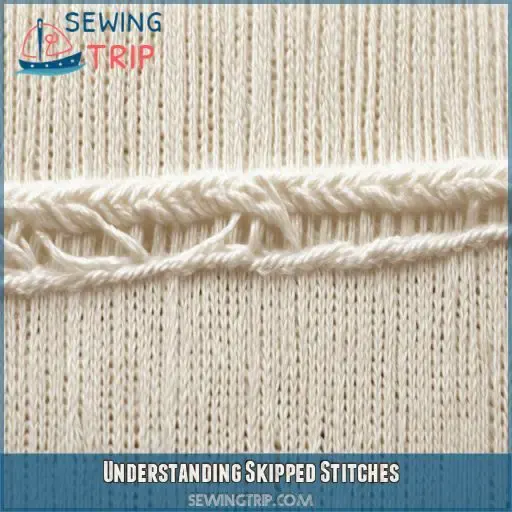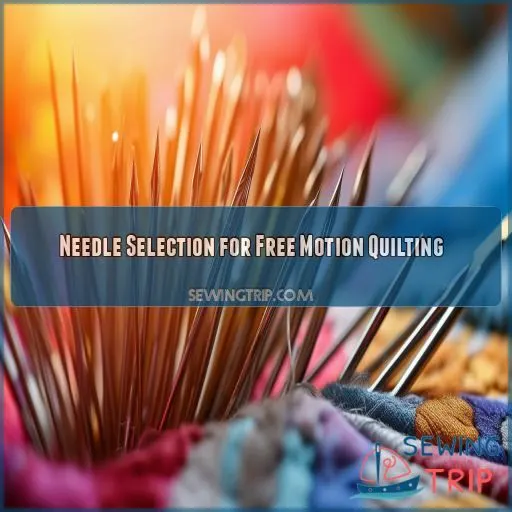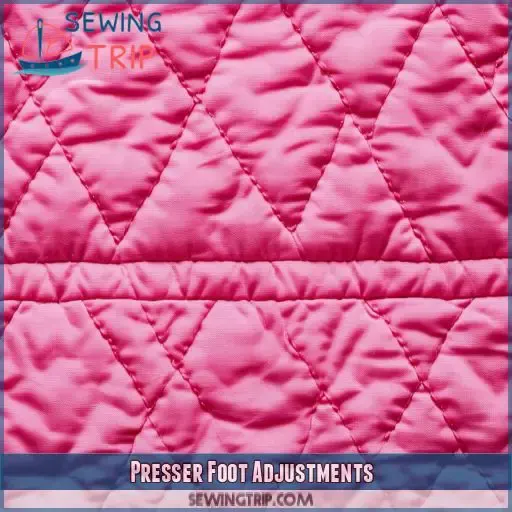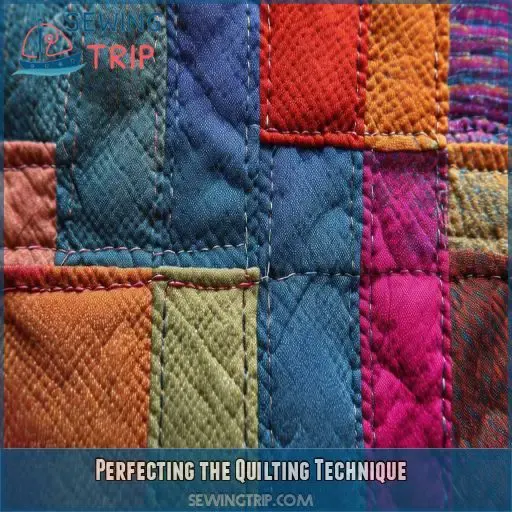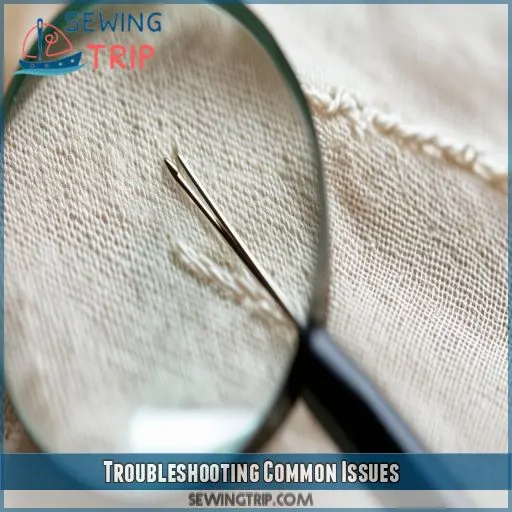This site is supported by our readers. We may earn a commission, at no cost to you, if you purchase through links.
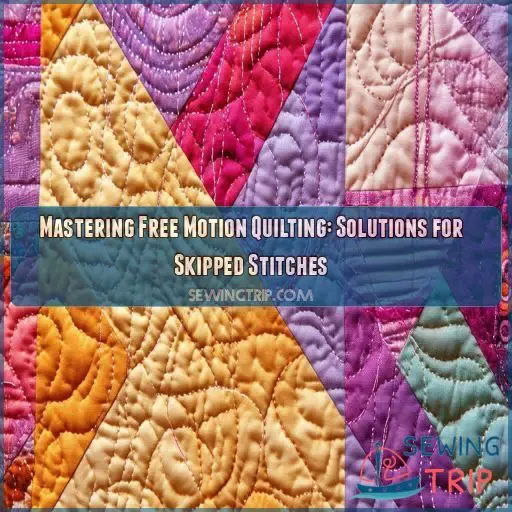 Frustrating, isn’t it? Those pesky skipped stitches ruin your free motion quilting rhythm.
Frustrating, isn’t it? Those pesky skipped stitches ruin your free motion quilting rhythm.
But fear not! Mastering this craft is within reach.
Prepare to unveil solutions that’ll transform skipped stitches from an infuriating obstacle into a conquered challenge.
By systematically addressing needle selection, tension adjustments, and quilting techniques, you’ll confidently quilt with flawless stitch formation.
Embrace the journey to free motion quilting mastery – your path to liberation awaits.
Table Of Contents
Key Takeaways
- Ensure needle and thread compatibility
- Balance bobbin and needle tension
- Thread machine correctly
- Maintain fabric tautness
Understanding Skipped Stitches
Ensure your needle and thread are compatible to prevent skipped stitches, while understanding the impact of tension on stitch quality is crucial for successful free motion quilting. Mastering machine threading techniques and proper needle insertion is key to overcoming issues with skipped stitches in your quilting projects.
Needle and Thread Compatibility
When it comes to free motion quilting, the harmony between your needle and thread is key. Ensure your needle is sharp, matching its size to the thread weight. Quality thread and the right needle type can make or break your stitches. Watch out for damaged needles causing skipped stitches, and fine-tune your thread tension for flawless quilting results.
The Role of Tension in Stitch Quality
When it comes to free motion quilting, mastering tension is key to flawless stitches. Ensure a perfect balance between bobbin and needle tension. Check thread compatibility and adjust tensions to avoid skipped stitches and thread breakage. Remember, a well-tensioned machine is your best friend for smooth quilting. So, rethread your machine, fine-tune bobbin orientation, and stitch away with confidence!
Machine Threading and Insertion Techniques
threading your machine can feel like a puzzle, but getting it right is key to smooth quilting. Ensure your needle insertion is spot on and the thread path isn’t missing any tension guides. If stitches still skip, it might be time to check for timing issues or seek repair options. Keep your machine clean for the best performance.
| Step | Tip | Why It Matters |
|---|---|---|
| Needle Insertion | Ensure it’s fully seated | Prevents skipped stitches |
| Thread Path | Follow guides precisely | Maintains consistent tension |
| Tension Adjustment | Use tension guides | Avoids loops and puckering |
| Machine Timing | Check for synchronization | Ensures smooth stitch formation |
| Maintenance | Regularly clean machine | Keeps everything running smooth |
Needle Selection for Free Motion Quilting
To ensure smooth free motion quilting, consider the importance of needle selection. Choose the right needle size for your thread weight, and be aware of specialty needles for specific fabrics.
Identifying Dull or Damaged Needles
Identifying Dull or Damaged Needles
To ensure optimal performance in free motion quilting, it’s crucial to inspect your needles regularly. Here’s how:
- Needle sharpness: A dull needle can cause fabric draw up, uneven fabric feed, and displacement of fabric yarns. Replace it with a new one.
- Needle replacement: Check for needle damage, such as bends or breaks. Replace them immediately to avoid further issues.
- Needle size: Match needle sizes with thread weight for best results.
- Needle types: Use the correct needle type for your machine and fabric. For tightly woven fabrics, consider microtex or sharp needles.
- Inspection: Regularly inspect your needles to catch any issues early.
Matching Needle Sizes With Thread Weight
When it comes to free motion quilting, matching needle sizes with thread weight is crucial for seamless stitching.
A needle gauge can help you determine the right needle size based on the thread thickness and type.
Needle sharpness is also important, as dull needles can cause skipped stitches.
Fabric density plays a role, too, as thicker fabrics may require a different needle.
So, always choose the right needle for your free motion quilting project to avoid skipped stitches and ensure a smooth stitching experience.
Specialty Needles for Specific Fabrics
When quilting with specialty fabrics like batiks, it’s crucial to select the right needles. Microtex needles are perfect for tightly woven fabrics, while topstitch needles have larger eyes. Ball point needles separate fibers instead of cutting. Remember to match needle sizes with thread weight and consider using microtex or ball point needles for batiks to enhance your quilting experience.
Presser Foot Adjustments
Choosing the right darning foot is crucial for smooth free motion quilting. Setting the correct presser foot pressure and opting for clear plastic soles can significantly enhance your visibility and stitch quality.
Choosing the Right Darning Foot
To master free motion quilting, it’s essential to choose the right darning foot. The darning foot, also known as a free motion foot, is designed to hover over the surface of your quilt, allowing you free range of movement in all directions. However, many darning feet are poorly designed, with a closed base that makes it difficult to see the needle and a top bar that hits your needle bar, causing the foot to hop with every stitch.
To improve the performance of your darning foot, consider these adjustments:
- Open Toe Feet: Open toe feet make it easier to thread the machine and pull the bobbin thread up to start stitching. They also improve visibility, as there’s nothing between you and the needle.
- Roller Feet: Roller feet are spring-loaded and offer more movement, which can be beneficial for some quilters.
- Microtex Needles: For tightly woven fabrics, consider using microtex or sharp needles, which can help prevent needle deflection.
- BSR Feet: BSR feet, such as those from LeahDay.com, are designed specifically for free motion quilting and can enhance the performance of your darning foot.
- Presser Foot Pressure: Increase presser foot pressure to limit fabric movement.
Setting the Correct Presser Foot Pressure
To ensure seamless free motion quilting, it’s crucial to set the correct presser foot pressure. Here’s how:
- Choose the right darning foot: The darning foot is generally suitable for free motion quilting, but consider other options if needed.
- Set the correct foot pressure: Adjust the foot pressure to limit fabric movement, as too much can cause stitch issues.
- Consider clear plastic soles: These provide better visibility, making it easier to navigate the quilt top.
- Test and adjust: Regularly check your tension settings and adjust as needed to maintain consistent stitch quality.
Benefits of Clear Plastic Soles for Visibility
Clear plastic soles on presser feet are a game-changer for enhancing visibility and precision when quilting. They provide a clear view of the fabric, allowing you to navigate the ever-evolving stitch path with ease. This improved visibility can help you tackle even the most complex quilting projects with confidence, ensuring your stitches are always on point.
Perfecting the Quilting Technique
To perfect your free motion quilting technique, focus on maintaining fabric tautness and mastering speed and movement control. With regular practice, you’ll see improvement and be well on your way to mastering free motion quilting.
Maintaining Fabric Tautness
To ensure flawless stitches, keep your quilt sandwich on a flat surface while quilting. Start by pressing your quilt top thoroughly to eliminate any wrinkles or creases. As you sew, maintain a steady speed and keep the target section taut, but not overly tight. This balance is key to avoiding skipped stitches and achieving professional-looking results. Remember, practice makes perfect!
Speed and Movement Control
Mastering speed issues and movement control is crucial for free motion quilting.
A steady, even hand speed helps prevent skipped stitches.
Don’t rush – think of it as a dance between your hands and the machine.
Adjusting presser foot pressure can also improve movement control, making it easier to guide the fabric.
Embrace the journey and unlock the secrets of smooth, skip-free stitches.
Practice Makes Perfect
Practice Makes Perfect
To master free motion quilting, you need to practice regularly. Here’s how:
- Consistent Practice: Regularly quilt on your machine to improve your skills.
- Patience and Persistence: Don’t get discouraged by initial difficulties; keep trying.
- Skill Development: As you practice, you’ll develop the skills needed for smooth stitching.
- Continuous Improvement: Keep experimenting with techniques and settings to enhance your work.
Troubleshooting Common Issues
When you encounter skipped stitches in your free motion quilting, it’s essential to understand the root cause and implement the appropriate solution. Let’s explore how to resolve tension imbalances, address fabric flagging, and know when to seek professional machine repair.
Resolving Tension Imbalances
To resolve tension imbalances in free motion quilting, you’ll need to adjust several factors.
Start by checking your bobbin tension. If it’s too loose, you’ll see loops on the quilt back.
Inspect the thread path for missed guides and ensure the presser foot is down.
Adjust needle tension and check the needle tension spring.
If you’re using a Janome 1600P DMX, consider scheduling a repair visit if the thread isn’t forming a loop or if you experience timing issues.
Addressing Fabric Flagging
Addressing fabric flagging can be a frustrating issue when free motion quilting. This problem is often caused by several factors, including tension adjustments, presser foot modifications, needle drag reduction, and speed optimization. Here are some tips to help you tackle fabric flagging:
- Tension adjustments: Check your needle tension and adjust it if necessary. Loose tension can cause loops on the quilt back, while tight tension can lead to skipped stitches. Make sure to test your thread tension on a sample sandwich before starting your project.
- Presser foot modifications: Ensure your darning foot is hovering over the top of your quilt, not pressing down too hard. If the foot is too high, lower it to maintain proper contact with the fabric. Modify the darning foot for correct height adjustment if needed.
- Needle drag reduction: Use a needle that’s sharp and not damaged. A blunt needle can cause skipped stitches. Consider changing the needle regularly to ensure it’s in good condition.
- Speed optimization: Maintain a steady stitching speed and avoid sudden changes in speed that can cause thread skipping. Practice regularly to improve your skills and become more comfortable with the machine.
- Experiment with different techniques and settings: Try various presser feet, such as larger surface area feet that reduce fabric flapping, or clear plastic soles that provide better visibility. Adjust your needle tension and presser foot pressure to find the optimal settings for your project.
When to Seek Professional Machine Repair
When to Seek Professional Machine Repair: Troubleshooting Common Issues
- Machine Timing: If your machine is consistently skipping stitches, it could be an issue with the timing of the needle and bobbin. A professional can check and adjust the timing to ensure the hook on the bobbin case catches the thread correctly.
- Bobbin Alignment: Improper bobbin alignment can cause skipped stitches. A professional can inspect and adjust the bobbin alignment to ensure the thread is correctly caught by the needle.
- Thread Breakage: If your thread frequently breaks during sewing, it could be due to a problem with the needle or the thread itself. A professional can help identify the issue and recommend the appropriate needle or thread for your project.
- Maintenance Schedule: Regular maintenance is essential for keeping your machine in top condition. A professional can help you establish a maintenance schedule and perform routine checks to prevent issues before they become major problems.
- User Error: Sometimes, skipped stitches can be caused by user error. A professional can provide guidance on proper needle insertion, threading, and sewing techniques to help you avoid skipped stitches in the future.
Conclusion
With over 21 million quilters in the United States alone, conquering skipped stitches in free motion quilting is a universal desire. You’ve explored needle selection, tension adjustments, and quilting techniques – now apply these solutions diligently. Consistent practice and troubleshooting will lead to flawless stitch formation, turning your quilting passion into a seamless artistic expression.

